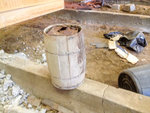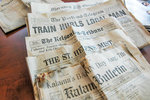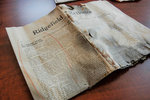


Were it not for an odd block of concrete buried underneath the floor of the long-closed confectionary store at 220 Pioneer St., next door to Ridgefield City Hall, chances are the contractors working on remodeling the site may have missed a chance to uncover some history.
The block was part of a support wall that spanned nearly 100 feet in length and supported the overriding floor, which had long since given into dry-rot and needed to be replaced.
Inside the block rested a wood barrel containing a rusted-out metal box full of newspapers, a photograph and other documents from 1926, only 17 years after the city was founded.
The contractor who uncovered it, who asked to remain anonymous, said he first mistook the block for a portion of an old chimney that had once existed in the building’s interior.
“I took a look at it, but because we needed to take four inches off it to make the new floor level, I gave it a whack with a hammer and I started seeing the wood of the barrel,” he said. “Once I got a better look and realized what it was, I was able to break it loose. The bottom was rotted out and the box inside was rusted through as well, but everything inside was in surprisingly good shape for how long it had been there.”
Within minutes of excavating it, the capsule was in City Hall, which itself is undergoing a renovation, and in the hands of Administrative Services Director Lee Knottnerus.
“We were tremendously excited by what was inside,” Knottnerus said. “Needless to say, we didn’t spend much time doing anything that day other than go through all the materials inside and see what was there.”
Among the old copies of the Kalama Bulletin, Kelsonian-Tribune, St. Helens Mist, Portland Telegram, and Morning Oregonian, was a copy of the Ridgefield Reflector from July 23, 1926, with a front page article, “R.E. Schroder Building New Confectionary Store.”
Built by contractor George W. Buker and designed by Vancouver architect Blaine Ackley, the little building at 220 Pioneer, which cost $5,000 to build, was nestled between what was then the Ridgefield State Bank, which is now City Hall, and the Ridgefield Telephone Office, now the Blue Heron.
Though the official name appears to be lost to history, the Schroeder’s store was known to residents of Ridgefield as “The Sweet Shop.”
“It was never really fancy, but it was a nice place to go,” said long-time Ridgefield resident John Burrows. “Roy’s daughter could usually be heard in the back of the shop practicing her violin, and her mother and sister were usually around since Roy had a main job as a shingle-weaver at a nearby mill.”
While the front of the Mission-style building was dedicated to the store and featured a soft drink counter, five booths and “stock shelves,” the back of the building was designed as a 24-foot living space complete with “a kitchen, dining room, bedroom and bathroom, plus an 8x25 porch.”
When it was finished in August 1926, Roy Schroder and his family moved into the building, vacating a space they leased from the Independent Order of Oddfellows (I.O.O.), which would soon build a new lodge on the second floor of what is now the Ridgefield Hardware and True-Value store, and the upper level is now a yoga studio.
Included with the newspapers were two “Official Certificates” from the I.O.O., which served as receipts for some form of payment, though sadly, the ink has been smudged to make the details difficult to read.
Although the evidence in the capsule indicates that people associated with Schroeder may have contributed to the formation of the time capsule, because of the deterioration of the contents over 87 years, a list of potential names has also become nearly impossible to identify.
Also, inside the capsule was an advertisement for a “benefit movie” at the Rainbow Theatre for Enchanted Hill: A Peter B. Kyne Story on Tues., July 27, 1926, with admission costing 15 and 35 cents, respectively. A very faded photograph of a young girl, with the name “Jean Schroder” on the back was the final piece of the capsule to survive, and Knottnerus is hoping to find information out about these people to provide more historical context and fill in the details.
“We’d love to talk to anyone who might have any familiarity with the Schroeders or had any memories of the Sweet Shop,” said Knottnerus. “What we plan to do with the capsule is figure out how to display it with other artifacts in City Hall, once the remodel is finished.”
As for the man who uncovered the capsule, he assured Knottnerus and the other people at City Hall that there were no gold coins or other objects considered valuable, and that he’s happy to have turned it over to the people of Ridgefield.
“I’m an antique collector in my spare time, so I know the value of finding something historical like this, and it didn’t take me long to decide it belonged to the city more than it could to me,” he said. “The amazing thing is, if I hadn’t had to shave those few inches off the block, it would still be there for maybe another hundred years because I would’ve encased it in a fresh pour of concrete to make the new floor.”
Anyone with potential information about the time capsule is encouraged to contact Lee Knottnerus at Ridgefield City Hall, (360) 857-5001, or via email, lee.knottnerus@ci.ridgefield.wa.us.